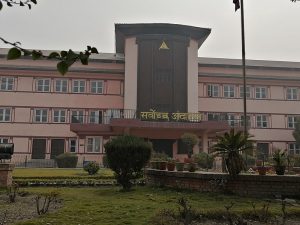Nepal’s judiciary is facing an unprecedented crisis. There are growing calls for the resignation of Chief Justice Cholendra Sumsher Rana.
Of the 19 judges in the Supreme Court, 18 have called on Rana to step down. The Nepal Bar Association, the umbrella organization of lawyers, has called for his resignation too. They have accused Rana of demanding posts for his relatives in the cabinet and constitutional bodies, failing to maintain judicial integrity, issuing controversial verdicts and stalling even basic judicial reforms.
Rana has struck a defiant posture.
Back in July, when the Supreme Court’s constitutional bench ruled against the dissolution of parliament by the then Prime Minister Khadga Prasad Sharma Oli (for the second time) and appointed Sher Bahadur Deuba as prime minister, Rana was hailed for upholding the Constitution.
Why has the “savior” of the constitution turned into a villain within a few months?
In early October, reports surfaced that Rana had demanded a share in distribution of posts in Prime Minister Deuba’s cabinet. As “payback” to Rana for his support in Oli’s ouster, Deuba reportedly appointed Gajendra Hamal as the minister for industry, commerce, and supplies. Hamal is a district-level leader of the Nepali Congress and Rana’s brother-in-law.
Following severe criticism Hamal resigned two days after his appointment. However, the damage was already done.
Rana has denied that there was any quid pro quo.
Experts say that the judiciary and the Chief Justice have run into controversies earlier as well. However, former Supreme Court Justice Prakash Osti says that the controversies involving Rana “have been higher in degree and intensity.”
Rana’s has courted controversies previously as well. He was appointed chief justice despite the parliamentary hearing committee having received nine complaints against him over his rulings. His decisions, especially on corruption cases, during his stint as the judge of Special Court were controversial, and some were later overturned by the Supreme Court.
Observers say that the current situation is a result of political meddling in the functioning of the judiciary, a flawed appointment process, and bad precedents. It lays bare widespread rot at most levels of decision-making. According to the Judges Society of Nepal, an association of incumbent and retired judges and justices, the problems that beset the judiciary are not going to end unless political interference in the working of the judiciary ends.
By seeking a share in the ministerial council and other political posts, Rana has made a mockery of the separation of power between the executive and the judiciary.
While there is no doubt that Rana’s personality and personal ambitions played an important role in the current crisis, systemic flaws created a conducive environment for the decay of the judicial system. The current controversy involving Rana has laid bare the ‘nexus’ between politics and the justice system. Many point out that Rana’s case is just a symptom and the cause is systemic.
The crisis in the judiciary has laid bare the rot in the Nepal judiciary, but it reflects even more poorly on the political parties. Nepal’s ruling parties have consistently twisted, and in some cases disregarded the rule of law. Therefore, they have sought to appoint sympathetic judges to the Supreme Court to aid their cause. This has created a system where some judges feel loyalty towards one party or another, and not to the rule of law.
Rana has been unwilling to resign so far. However, the parliament can impeach him. It will need a two-thirds majority to do so, which may not be easy in the current situation where parliament is highly fractured and factionalized.

































